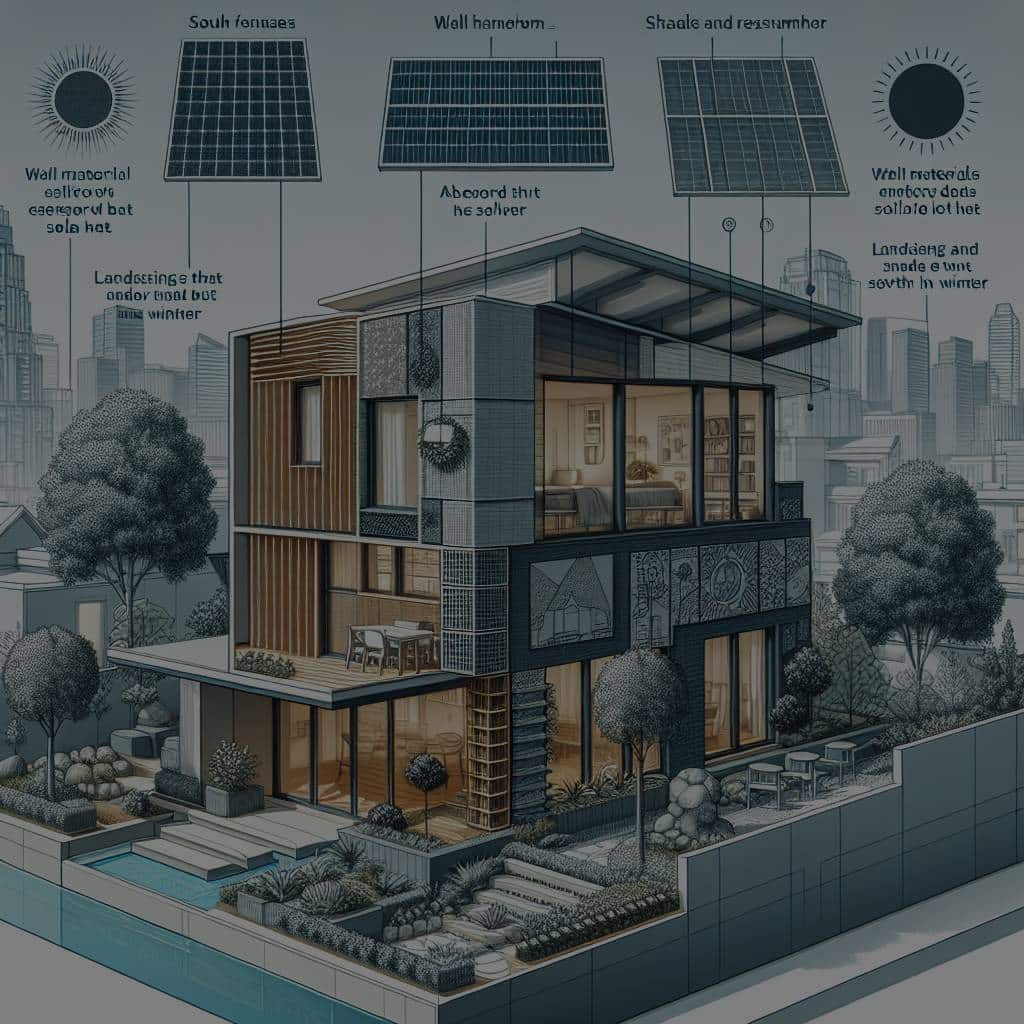How to Implement Passive Solar Design in Urban Homes?

In the quest for sustainable and energy-efficient homes, passive solar design has risen as an approach that marries technological innovation with nature’s wisdom. It’s a design strategy that uses the sun’s heat and light to our advantage, helping us warm our homes in the winter and cool them in the summer. But how exactly can you incorporate this design into your urban home? Through heating and cooling strategies, utilizing thermal mass, orienting your building correctly, considering ventilation and choosing the right windows and walls, you can fully take advantage of this energy-efficient design option.
The Fundamentals: Heating and Cooling Strategies
To start with, understanding heating and cooling strategies is essential. In a nutshell, passive solar design is about capturing the sun’s heat when you need it and avoiding it when you don’t. How does this work? During winter, when the sun is low in the sky, it can shine directly into your house, offering free heat. Conversely, in summer when the sun is high, properly designed overhangs or shading devices can block the sun, helping to keep the house cool.
Have you seen this : How to Secure Real Estate Financing for Self-Build Projects?
But it’s not all about the sun. Cooling strategies can also include allowing hot air to escape from your home, using techniques like stack ventilation where hot air rises and exits through higher openings, pulling cooler air in from lower openings. Remember, passive solar design isn’t just about harnessing the sun’s energy, but also about promoting efficient air movement within your home.
Utilizing Thermal Mass
Next, let’s look at the concept of thermal mass. In passive solar design, thermal mass plays a crucial role. It refers to materials in your building that can absorb, store and later release heat. Think of it as a thermal battery for your house. During the day, these materials (like concrete, brick or stone) absorb heat from the sun. Then, as the temperature drops at night, they slowly release this stored heat into your home.
Also to read : What Strategies Can Be Employed to Reduce Gentrification Impacts in City Regeneration?
A well-designed passive solar house will have enough thermal mass to store heat during the day and release it at night, helping to maintain a comfortable temperature. However, it’s not just about having thermal mass, it’s about placing it where it can absorb sunlight during the day. Therefore, it’s important to consider the placement of your thermal mass in relation to windows and other areas where sunlight enters your home.
Building Orientation and Design
Building orientation is another critical aspect of passive solar design. Your house should ideally be designed with its long axis running east to west. This allows the south-facing windows to capture maximum sunlight in the winter, while north-facing windows can help illuminate your home without adding much heat.
Moreover, the design of your house can also contribute to your passive solar strategy. An open floor plan can facilitate the movement of heat and air, while high ceilings can allow hot air to rise away from your living spaces. The shape of your house matters too. A compact shape with less surface area can reduce heat loss in winter and heat gain in summer.
Windows, Walls, and Ventilation
When it comes to passive solar design, not all windows and walls are created equal. South-facing windows are typically the workhorses, letting in the low winter sun to heat your home. These windows should be double-glazed to minimize heat loss, and ideally, they should have a high solar heat gain coefficient (SHGC), meaning they let in a lot of solar heat.
On the other hand, your walls play a crucial role in keeping the heat in or out. Insulated walls can prevent heat loss in the winter and heat gain in the summer. Similarly, good ventilation is key to cooling your home in the summer. It can be as simple as opening windows to let in a breeze or as elaborate as designing a whole-house ventilation system.
The Importance of Glass Selection
Finally, the type of glass you choose for your windows can significantly impact the energy performance of your home. Low-E glass, which stands for low emissivity, has a thin coating that reflects heat back to its source. This means in the winter, it reflects heat back inside your house, and in the summer, it reflects the sun’s heat back outside.
Remember, incorporating passive solar design into your urban home is not a one-size-fits-all solution. It requires careful planning and design. But the payoff is a home that is more comfortable, more energy-efficient, and works in harmony with nature. The sun is a powerful resource–it’s time we used it to our advantage.
Natural Ventilation and the Role of Landscaping
Natural ventilation is another important element in passive solar design. This refers to the process of supplying and removing air through an indoor space without using any mechanical systems. It’s all about harnessing the natural movements of air caused by wind and differences in air temperature.
For instance, when air heats up, it expands and rises, and when it cools down, it contracts and falls. This principle can be used in your home design through a technique called thermal buoyancy or the stack effect. By including features such as high ceilings, open stairwells, or ventilated skylights, you can help the warm air rise and exit the house, pulling in cooler air from lower openings.
On the other hand, cross ventilation occurs when the air moves horizontally through the building. This can be achieved by carefully placing windows and doors across from each other to encourage airflow.
However, natural ventilation isn’t only about the design of your house. It also involves the use of landscaping to guide cool breezes towards your home or to act as a windbreak, reducing the impact of hot winds. Deciduous trees can provide shade in the summer, but let sunlight through during the winter when their leaves have fallen.
In addition to natural ventilation, a Trombe wall could be used to generate passive solar energy. This is a wall, usually made of a material with high thermal mass, that absorbs sunlight during the day and releases it at night. The wall is typically placed behind a glass panel, creating a small airspace. The solar heat is trapped in this space, slowly transferred to the wall, and then released into the house during the cooler night hours.
Sustainable Materials and Renewable Energy Integration
While passive solar design primarily focuses on leveraging the sun’s heat, it’s also important to consider the role of materials in your home. Choosing sustainable materials can further enhance the energy efficiency of your home.
For instance, consider installing insulation made from recycled or renewable materials. This not only reduces the energy needed to heat and cool your home but also decreases the environmental impact of your building materials.
In the same vein, the emphasis on energy efficiency shouldn’t stop at passive solar design. Integrating renewable energy sources, such as solar panels or wind turbines, can make your home even more sustainable. While passive solar design reduces the need for active heating and cooling, these renewable energy sources can cover the remaining energy demand, making your home truly energy independent.
Remember, integrating passive solar design into your home is a process that involves careful planning and design. Still, the result is a comfortable indoor environment that saves energy, reduces your carbon footprint, and works in harmony with the natural environment.
Conclusion
Incorporating passive solar design in urban homes is a practical and sustainable way to enhance energy efficiency, provide comfortable indoor spaces, and reduce environmental impact. Understanding the principles of heating, cooling, and thermal mass, along with correct building orientation, window, and wall choices, are fundamental to effective solar design.
Further enhancements can be made through considered selection of glass, sustainable materials, and integration of renewable energy sources. In essence, a well-designed passive house is more than just a structure—it’s a sophisticated, energy-efficient system that works in harmony with its environment to provide a comfortable and sustainable living space.
As urbanization continues, and the need for renewable energy sources becomes more pressing, it’s clear that passive solar design will play an increasingly important role in the future of urban living. So, let’s harness the power of the sun and reap the benefits of this innovative and sustainable approach to home design.
